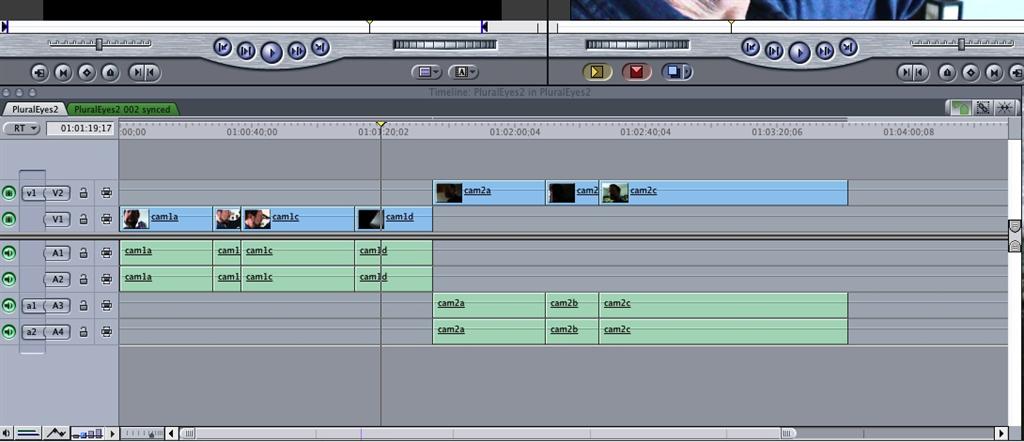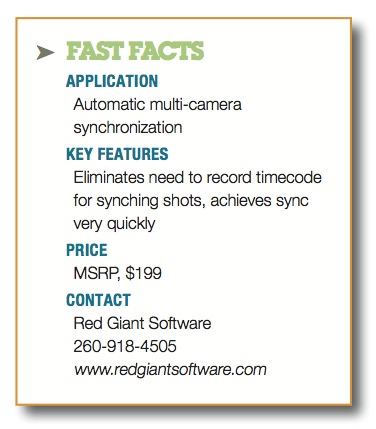Red Giant Software’s PluralEyes 2.0-3.0

PluralEyes user interface with clips ready to be synced up.
PluralEyes is a software application that automatically synchronizes multiple video cameras by matching their audio waveforms. It can be used for any type of multicamera shoot, and eliminates the need for cameras to be synced by timecode or slate. It’s also ideal for shooting with a DSLR camera and capturing audio on a separate recorder. PluralEyes 2.0 is designed to work seamlessly with Avid Media Composer, Final Cut Pro X and 7, Adobe Premiere Pro, Sony Vegas and Edius editing platforms.
Red Giant Software acquired PluralEyes and released PluralEyes 3.0, which is a standalone product that works independently of a specific NLE application. It’s currently only available for Mac operating systems, although a Windows version will be made available soon.
FEATURES
PluralEyes eliminates the need for manually syncing multiple camera streams. Employing a sophisticated algorithm, PluralEyes identifies identical waveforms, and then aligns the different video clips to match them.
As an example, let’s say you’re shooting a dance performance with four cameras. To prepare for syncing the cameras in post, all that’s necessary is to make sure each camera is recording audio, then create a sequence on your NLE and place the video/audio clips on separate tracks. Open up the PluralEyes application and then start the syncing process. Within moments a new sequence is created with all of the separate video clips vertically aligned on separate tracks in perfect sync.

A very common use for PluralEyes is in syncing video shot on a DSLR camera with audio recorded on a separate recorder. (With DSLR cameras, it’s become common practice to record the audio on a separate device to improve quality and eliminate cable connections; however, at the end of the day, you have a collection of audio and video clips that have to be reunited.) PluralEyes makes the process quick and simple. Simply create a sequence on your editing platform of choice, place the audio and video clips (with accompanying audio) on the timeline and run it through PluralEyes. The program makes a copy of the sequence with the video clips automatically synced to the separately recorded audio.
PluralEyes will work with any material you give it as long as the video has intelligible audio recorded with it. If you’re shooting with a DSLR, you must record audio in-camera; however, this is only used for alignment. Once the video is married to the separately recorded audio, you can remove the camera audio.
The PluralEyes interface is intuitive and very easy to use. There are a few options to improve efficiency. For example, you can check boxes that level uneven audio or enable greater efficiency with clips placed in chronological order. And if you have a difficult syncing job, you can select the box labeled “Try really hard.” It adds a bit more processing time, but often overcomes pesky hurdles. In any case, the syncing time is very fast.
IN USE
I tested PluralEyes 2.0 on Final Cut Pro 7 and Avid Media Composer 6. Although I did not test PluralEyes on Final Cut Pro X, I’ve been told by other editors that it functions equally as well.
I was given two sets of footage comprised of dancers performing to a music track in a studio setting. This was shot simultaneously on two Canon 7D DSLR cameras with no timecode.
Such a job usually requires slates or synchronous timecode. Both have their disadvantages. Slating can get derailed when cameras are turned on and off, and syncing cameras to common timecode requires sophisticated equipment. If anything goes awry, the editor ends up syncing the clips manually—a frustrating and time consuming task. With PluralEyes, all you need is cameras of any kind that record video and audio.
To prepare for syncing with PluralEyes, I created two sets of tracks for each camera. I then placed the two sets of video/audio clips randomly on the timeline.
When used with Avid’s Media Composer, syncing with PluralEyes is a simple three-step process. After making your multicamera sequence, you export the timeline as an AAF file. Then, you import it into PluralEyes and press the “Sync” button. PluralEyes creates a new sequence with your original clips synchronized according to common audio. You then import that back into Avid and continue to edit from there.
My first test worked almost perfectly. All of the clips that could be synced were grouped together. A few were not. PluralEyes works almost miraculously, but it helps if you incorporate a bit of planning if you want perfect results every time. I tried the task again, this time laying down a complete audio track, which was recorded on a separate recorder in the studio, and everything synced perfectly to the master audio track. For my second experiment I performed a task common for every videographer—an interview covered by two cameras—and I have to say that here, PluralEyes proved to be one of the most remarkably useful tools I’ve ever used.
In this test, I followed a talking subject with two cameras as he gave a tour of a building. The cameras were turned on and off at random intervals. I then went to Final Cut Pro 7 for editing. As with Avid, I created a sequence and laid the video/audio clips on the timeline in separate vertical tracks. I laid them in randomly to test the ability of PluralEyes to create order from chaos.
It turns out that PluralEyes was even easier to use with Final Cut Pro. When I activated the application, it automatically located the sequences in the bin. I selected the one I wanted to sync, and it not only quickly performed the job, but also created a synced copy of the original sequence with a colored tab to make it easy to find. With Final Cut Pro, syncing footage in a sequence is a one-step operation.
As a result, I had the original sequence, and a duplicate synchronized sequence on the timeline. And as a bonus, PluralEyes also placed a new clip in the bin that enabled me to see up to four synchronized camera streams simultaneously in the clip-viewing window.
SUMMARY
PluralEyes is simply one of the best inventions since digital video. Every editor and videographer should have it, as it eliminates the need for slates and other cumbersome A/V syncing methods. It is format agnostic. You can synchronize video tracks from any source, as it’s all done by matching sound. PluralEyes integrates seamlessly with all major NLE platforms and its ease of use, simple interface, and very affordable price point hide that fact that it’s an enormously efficient and sophisticated tool.
Geoff Poister, Ph.D., is a member of the Film and Television faculty at Boston University and a regular contributor to TV Technology.
Get the TV Tech Newsletter
The professional video industry's #1 source for news, trends and product and tech information. Sign up below.
